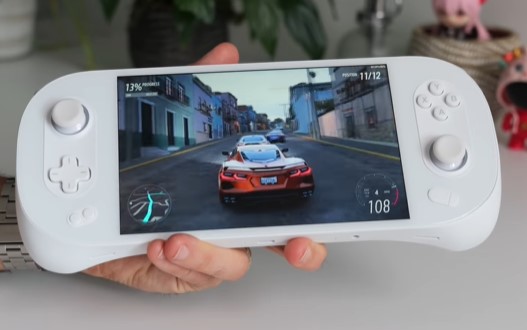These Handheld Consoles offer hours of enjoyable gameplay and easily fit into your pocket when you’re done. Our selection includes options for cloud-based gaming, Android, and Windows games, allowing you to play console and PC games on the go.
1. Nintendo Switch OLED

Let’s start with the Nintendo Switch OLED. Released a few years ago, this slim gaming console features a 7-inch screen, perfect for enjoying Nintendo’s colorful games. Though it may not have the performance of some competitors, its wide range of games, including indies, makes it a great option for gaming on the move. With the Switch OLED, you can expect around four to five hours of battery life per charge.
Related: Steam Deck vs Asus ROG Ally
2. Steam Deck

At number two, the Steam Deck handheld gives you easy access to a huge range of games on Steam. Even though its design may seem a bit old-fashioned, the Steam Deck is powerful enough to handle most PC games, which is great if you have a lot of games in your Steam library.
One thing to note is that its screen is pretty basic compared to the Switch OLED. It’s an IPS screen, so it doesn’t have the vibrant colors you’d find on the Switch OLED. While the HD resolution is similar, the screen’s refresh rate is only 60Hz, which might not be as smooth as some other handhelds running Windows
Read Also: Nintendo Switch OLED vs Asus ROG Ally
3. Asus ROG Ally

For Windows gamers, consider the Asus ROG Ally, It’s a big step up from the Steam Deck. With its clear 7-inch Full HD display using IPS technology, you get brighter, sharper visuals. Plus, it has a 120Hz refresh rate and supports AMD FreeSync, giving you a smooth gaming experience. While it’s not the most portable option, its design and built-in features, like a fingerprint sensor and the Armory Crate app, make it a really attractive choice.
4. Ayaneo Air 1S and 2S

Among the AYANEO’s models I’ve tested, the AYANEO Air 1S handheld stands out as a great option if you want something portable. It’s noticeably smaller than the Steam Deck and the ROG Ally, resembling the Nintendo Switch. Despite its small size, it features an AMD Ryzen 7 processor and a stunning AMOLED screen.
The AYANEO 2S is a proper Steam Deck-style mega handheld gaming console, offering upgraded performance that lets you play even the most demanding PC games without sacrificing frame rate. However, it’s larger than the Air 1S, and it swaps out the AMOLED screen for a simpler IPS panel.
5. OneXPlayer 2

The OneXPlayer 2 with detachable controllers, stands out for its ease of docking and playing on a big screen. Its performance competes with the best, providing a smooth gaming experience.
6. Lenovo Legion Go

At number six, we have the Lenovo Legion Go, an impressive handheld that pushes the boundaries of what gaming consoles can offer. Although it’s quite large and heavy (with an 8.8-inch Quad HD touchscreen weighing 850g), it makes a bold statement in the gaming world.
The 144Hz IPS screen delivers crisp and smooth visuals, paired with dual 2-watt speakers for immersive audio. Powered by AMD’s Ryzen Zen 1 Extreme processor, the same one found in the ASUS ROG Ally, and equipped with a Liquid Crystal Polymer 79-blade fan, the Legion GO ensures seamless performance, handling demanding titles with ease.
A standout feature is the detachable TrueStrike controllers, similar to Xbox controllers, which can be removed and attached to a bundled base. Activating FPS mode turns the controller into a versatile freeform joystick, enhancing the gaming experience.
7. Razer Edge

If Windows isn’t your go-to operating system for a gaming handheld, or if you’re just curious about other options, Android presents itself as a solid choice. One notable Android gaming console is the Razor Edge, essentially a compact 6.8-inch tablet with a Kishi V2 controller seamlessly attached. Featuring a stunning 144Hz AMOLED screen, the Razor Edge runs on the Qualcomm Snapdragon G3x Gen 1, ensuring strong performance akin to a sack full of steaks.
The Razor Edge is great for handling demanding Android games like Genshin Impact, even on higher graphic settings. With the Kishi controller, you can remap touch controls, which significantly improves the gaming experience. Devices like the Razor Edge are often made with cloud gaming in mind.
Subscribers to services like Xbox Cloud Gaming or Nvidia’s GeForce Now can enjoy playing full PC titles anywhere. This includes recent releases like Alan Wake 2 or Apex Legends Ignite. Notably, the Razor Edge works with PS Remote Play, so PS5 users can stream games over home Wi-Fi to wherever they want, whether it’s on a comfy throne or snuggled under a cozy duvet.
8. Logitech G Cloud

For a more affordable handheld console option, consider the Logitech G-Cloud. However, it doesn’t offer a 5G option, limiting online gaming to Wi-Fi connectivity. Its 60Hz IPS display, while not as vibrant as the AMOLED on the Razor Edge, still provides decent quality.
The Logitech G-Cloud comes with a less powerful engine, housing the Qualcomm Snapdragon 720G, which may not be ideal for serious Android gaming. Additionally, the physical control mapping for Android games isn’t very effective, performing about as well as a safety helmet made of marshmallow. While the Logitech G-Cloud is budget-friendly, it lacks the power and performance needed for serious Android gaming.

